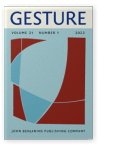Vol. 21:1 (2022) ► pp.115–149
Coordinating and sharing gesture spaces in collaborative reasoning
In collaborative reasoning about what causes the seasons, phases of the moon, and tides, participants (three to four per group) introduce ideas by gesturing depictively in personal space. Other group members copy and vary these gestures, imbuing their gesture spaces with similar conceptual properties. This leads at times to gestures being produced in shared space as members elaborate and contest a developing group model. Gestures in the shared space mostly coincide with conversational turns; more rarely, participants gesture collaboratively as they enact a joint conception. An emergent shared space is sustained by the joint focus and actions of participants and may be repositioned, reoriented, or reshaped to meet changing representational demands as the discourse develops. Shared space is used alongside personal spaces, and further research could shed light on how gesture placement and other markers (such as eye gaze) contribute to the meaning or function of gestures in group activity.
Article outline
- Introduction
- Descriptions of gesture space
- Personal gesture space
- Viewpoint, scale, and status
- Interpersonal space and alignment of gesture spaces
- Mutual orientation and environmentally coupled gestures
- Summary
- Study of collaborative reasoning
- Findings
- Collaborative model building
- Appropriating and elaborating others’ gestures in personal space
- Re-aligning gesture space to share perspective
- Moving from personal to shared space
- Collaborative gesturing
- Discussion
- Conclusion
- Note
-
References
